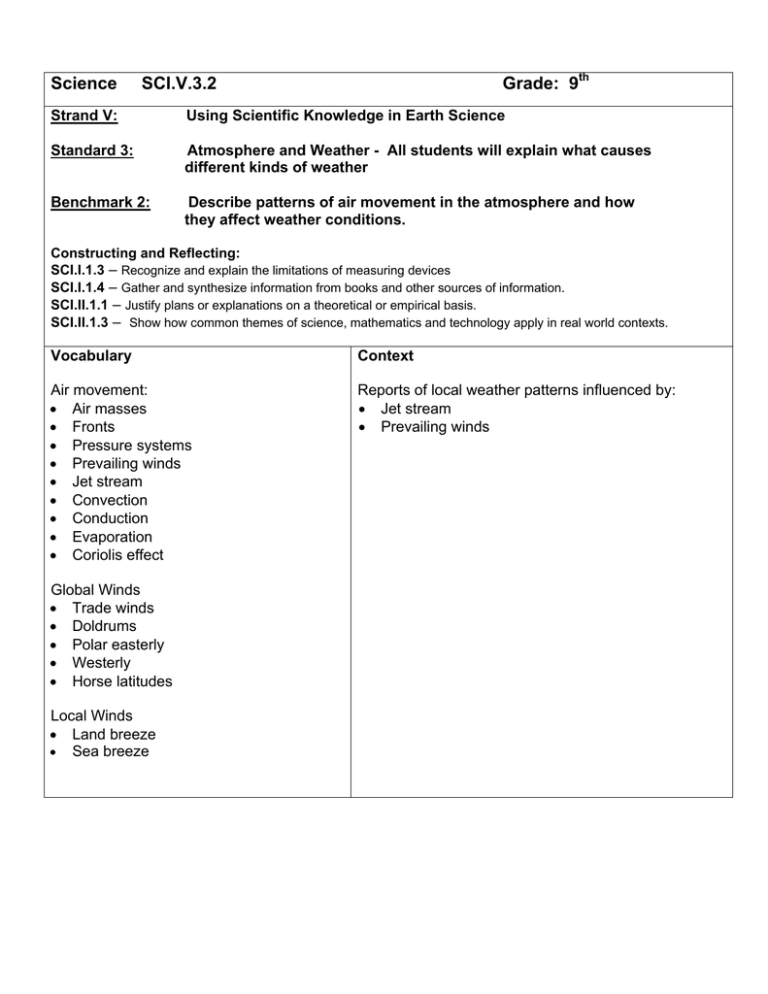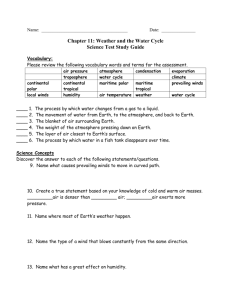Science SCI.V.3.2 Grade: 9
advertisement

Science Grade: 9th SCI.V.3.2 Strand V: Using Scientific Knowledge in Earth Science Standard 3: Atmosphere and Weather - All students will explain what causes different kinds of weather Benchmark 2: Describe patterns of air movement in the atmosphere and how they affect weather conditions. Constructing and Reflecting: SCI.I.1.3 – Recognize and explain the limitations of measuring devices SCI.I.1.4 – Gather and synthesize information from books and other sources of information. SCI.II.1.1 – Justify plans or explanations on a theoretical or empirical basis. SCI.II.1.3 – Show how common themes of science, mathematics and technology apply in real world contexts. Vocabulary Context Air movement: • Air masses • Fronts • Pressure systems • Prevailing winds • Jet stream • Convection • Conduction • Evaporation • Coriolis effect Reports of local weather patterns influenced by: • Jet stream • Prevailing winds Global Winds • Trade winds • Doldrums • Polar easterly • Westerly • Horse latitudes Local Winds • Land breeze • Sea breeze Knowledge and Skills Students will: • Explain how changes in the weather result from the movement of air masses • Explain how barometric pressure affects weather • Explain will explain the movement of wind around low pressure and high pressure areas • Explain that when air moves vertically, clouds may result. • Explain that patterns of air movement in the atmosphere affect weather conditions. Air motion is caused by differences in pressure, density, and temperature. • Explain that horizontal motion of air (wind) is altered by the rotation of the Earth / Coriolis Effect. Fronts are often areas of storminess caused by the interaction of air masses. Surface weather patterns are guided by the jet stream (an upper level wind moving across the U.S. from west to east). Other Resources:(continued from column at right) • Videoconferences Available For more information, see www.remc11.k12.mi.us/dl or call Janine Lim 471-7725x101 or email jlim@remc11.k12.mi.us IV.3.HS.2 Energy from COSI Toledo REMC Materials: V.3.HS.2 Describe patterns of air movement in the atmosphere and how they affect weather conditions. Vernier probes available: Relative Humidity Sensor, Barometer, Temperature Probe Resources Coloma Resources: Glencoe CH 11 Atmosphere CH 12 Meteorology CH 13 The Nature of Storms Glencoe MiniLabs Pg 47 Angle of Sun’s Rays Pg 48 Interpreting Weather Maps Pg 52 Tracking A Hurricane Glencoe Labs 12.2 Predicting the Weather Other Resources: • Michigan Teacher Network Resources • Michigan Weather Conditions: http://www.wunderground.com/forecasts/MI.html • Weather Channel Online • The Wind Air in Motion: succinct primer on the causes and characteristics of wind. • Does Weather Happen Randomly? • Wind with Miller • Convection currents – make your own. • Scope Unit – Weather and Climate • National Severe Storms Laboratory – NSSL / NOAA Resources for Teachers • Nearest NOAA Weather Station for wind data. • Bill Nye Atmosphere video • • USA Today Weather Information and Sites for Teachers CNN Weather Pages • National Weather Service Climate Prediction Center – Educational Materials – OUTSTANDING! Instruction Benchmark Question: How do horizontal motions of the air vary and contribute to the type of weather? Focus Question: How does the wind direction vary in your community? The teacher will review with students that winds are named according to the direction from which they come. A north wind, for example, comes from the north! Students will work with a partner and use a packet of wind data from the weather service to plot the data on a frequency graph e.g., a wind rose diagram to determine the general pattern. Students will use weather map data from newspapers, the internet, or the weather channel to determine which direction large weather systems generally move across the United States. In a paragraph, each student will explain how local wind data is related to the motion of large weather systems across the United States. Assessment The teacher will present the following scenario to the class: A group of meteorology students has already completed a study in which they compare the wind direction and temperature of many cities before and after a cold front passes. They wish to display their wind direction data on a wind rose diagram. Each student will draw a likely wind rose diagram for all of those cities before the front passes and after the front passes. Each student will write a prediction of what changes in temperature might be expected due to a change in wind direction caused by the passage of the front. (Give students rubric before activity.) Criteria Apprent. Basic Meets Exceeds Identificatio n of wind direction before and after the front Identifies change in wind direction with an incorrect compass direction(s). Identifies wind direction before or after front passage. Identifies wind direction before (SSW) and after (NWN) front passage. Identifies wind direction before (SSW) and after (NW-N) front passage. Drawing of wind rose diagram before and after the front passes Names compass direction. Names compass direction and identifies wind direction. Names compass direction and identifies wind direction and wind duration. Names compass direction, identifies wind direction and duration, and explains effect of frontal speed on wind duration. Associate s change in wind direction with changes in temperatu re (S-SW = warmer, N-NW = cooler). Associates change in the wind direction with changes in temperature and explains how speed of frontal movement alters changes in wind direction and temperature. Accuracy of Associate Associates predictions s either change in change in wind wind or direction change in with temperatu temperatur re with e change frontal (incorrect passage. association). Teacher Notes: Explain what causes different kinds of weather. The causes of different weather are not a priority in the elementary grades. The foundation for the causes of different kinds of weather is laid as young learners are able to identify the states of water (see the Hydrosphere). Students may believe that when water evaporates it disappears all together rather than just changing form. They may also think that it just changes location and is still a liquid. Late elementary students may understand that evaporated water is still in the air. Ideas such as air pressure and temperature changes with altitude become important in explaining the causes of different kinds of weather. Different forms of precipitation, relative humidity, dew point, and fog require this type of knowledge. Some students may think that water vapor and steam are held or soaked up by the air. They may not understand that steam, like air, is a gas and mixes with the other gases in the air and that water vapor is a liquid held in the air. As temperature increases more water vapor enters the gas phase. Students also envision that humid air is "heavier" than dry air. In fact, humid air is actually less dense than dry air of the same temperature. At the high school level, students will describe patterns of air movement in the atmosphere and how these patterns affect weather conditions. Pressure systems are particularly difficult to understand because air moves from high to low pressure.








